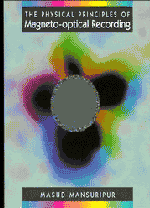Book contents
- Frontmatter
- Contents
- Preface
- 1 Overview of Optical Data Storage
- 2 Optics of Gaussian Beams
- 3 Theory of Diffraction
- 4 Diffraction of Gaussian Beams from Sharp Edges
- 5 Optics of Thin Films and Multilayers
- 6 Magneto-optical Readout
- 7 Effects of High-numerical-aperture Focusing on the State of Polarization
- 8 Computer Modeling of the Optical Path
- 9 Noise in Magneto-optical Readout
- 10 Modulation Coding and Error Correction
- 11 Thermal Aspects of Magneto-optical Recording
- 12 Fundamentals of Magnetism and Magnetic Materials
- 13 Magnetostatics of Thin-film Magneto-optical Media
- 14 Mean-field Analysis of Amorphous Rare Earth–Transition Metal Alloys
- 15 Magnetization Dynamics
- 16 Origins of Coercivity
- 17 The Process of Thermomagnetic Recording
- 18 Media Characterization
- References
- Index
9 - Noise in Magneto-optical Readout
Published online by Cambridge University Press: 07 September 2010
- Frontmatter
- Contents
- Preface
- 1 Overview of Optical Data Storage
- 2 Optics of Gaussian Beams
- 3 Theory of Diffraction
- 4 Diffraction of Gaussian Beams from Sharp Edges
- 5 Optics of Thin Films and Multilayers
- 6 Magneto-optical Readout
- 7 Effects of High-numerical-aperture Focusing on the State of Polarization
- 8 Computer Modeling of the Optical Path
- 9 Noise in Magneto-optical Readout
- 10 Modulation Coding and Error Correction
- 11 Thermal Aspects of Magneto-optical Recording
- 12 Fundamentals of Magnetism and Magnetic Materials
- 13 Magnetostatics of Thin-film Magneto-optical Media
- 14 Mean-field Analysis of Amorphous Rare Earth–Transition Metal Alloys
- 15 Magnetization Dynamics
- 16 Origins of Coercivity
- 17 The Process of Thermomagnetic Recording
- 18 Media Characterization
- References
- Index
Summary
Introduction
The present chapter is devoted to the analysis of the various sources of noise commonly encountered in magneto-optical readout. Although the focus will be on magneto-optics, most of these sources are known to occur in other optical recording systems as well; the arguments of the present discussion, therefore, may be adapted and applied to various other media and systems.
The MO readout scheme considered in this chapter is briefly reviewed below, followed by a description of the standard methods of signal and noise measurement, and the predominant terminology in this area. After these preliminary considerations, the characteristics of thermal noise, which originates in the electronic circuitry of the readout, are described in section 9.1. Section 9.2 considers a fundamental type of noise, shot noise, and gives a detailed account of its statistical properties. Shot noise, which in semiclassical terms arises from the random fluctuations in photon arrival times, is an ever-present noise in optical detection. Since the performance of MO media and systems is approaching the limit imposed by shot noise, it is imperative to have a good grasp of this particular source of noise. In section 9.3 we describe a model for laser noise; here we present measurement results that yield numerical values for the strength of laser power fluctuations. Spatial variations of disk reflectivity and random depolarization phenomena also contribute to the overall level of noise in readout; these and related issues are treated in section 9.4.
- Type
- Chapter
- Information
- The Physical Principles of Magneto-optical Recording , pp. 295 - 328Publisher: Cambridge University PressPrint publication year: 1995
- 2
- Cited by



